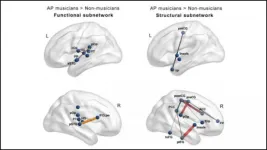(Press-News.org) January 25, 2021 -- In a study to gain understanding of the future public health workforce, researchers at Columbia University Mailman School of Public Health and the Association of Schools and Programs of Public Health (ASPPH), conducted a large-scale analysis of the first employment outcomes of public health graduates and found that 78 percent were employed including 5 percent employed in fellowships and internships. Fifteen percent were continuing their studies; only 5 percent were not employed and job seeking. These indicators may ultimately expand public health's reach and lead to healthier communities overall. The study is the first national analysis of employment outcomes of public health graduates, and one of the only such analyses ever conducted. The results are published in the American Journal of Public Health.
"We conducted an assessment of first-destination outcomes of public health graduates to ensure that there are enough trained public health professionals to fill rapidly changing workforce demands," said Heather Krasna, MS, assistant dean and director of career services at Columbia Mailman School, and a co-lead author of the study. "It is important for both academia and practice to know that graduates have a wide choice of employment options, stretching beyond government and into academia and the health care, nonprofit, and for-profit sectors."
Using descriptive statistics and the Pearson χ2 test, the researchers assessed first-destination employ- ment and educational outcome data reported by members of ASPPH, the membership organization for domestic and international Council on Education for Public Health-accredited schools and programs of public health. The data included 64,592 public health graduates, of which 53,463 had a known first-destination outcome, from the graduating years 2015-2018. There were 9,513 graduates from 55 institutions in 2015, 13,588 graduates from 75 institutions in 2016, 20,394 graduates from 112 institutions in 2017, and 21,097 graduates from 111 institutions in 2018. Across the pooled data, 31 percent of graduates were from bachelor's, 63 percent from master's, and 7 percent from doctoral degree programs.
The researchers found that overall, 73 percent of graduates in public health were employed; 15 percent enrolled in further education; 5 percent entered a fellowship, internship, residency, volunteer, or service program; and 6 percent were not employed (including 1 percent not job seeking by choice). Employed graduates went to work in health care (27 percent), corporations (24 percent), academia (19 percent), government (17 percent), and nonprofit (12 percent). In 2018, 9 percent of bachelor's, 4 percent of master's, and 2 percent of doctoral graduates were not employed but seeking employment by a year after graduation. Employment by degree level shows that graduates with advanced public health degrees had better employment outcomes.
The authors make the point that with the growth and changes in public health degree programs, it is important to know which areas of study are achieving the best employment outcomes, identify which sectors are recruiting these graduates, and help schools and programs of public health communicate their impact to prospective students, and employers.
"Graduates' first-destination outcomes provide academia insight into changes in the job market, which may then inform decisions on the degrees and areas of study an institution offers," observed Christine Plepys, senior director of data analytics at ASPPH, and co-lead author of the study. "A school's or program's ability to prepare graduates with the competencies demanded by the workforce may help ensure student success, not only in finding employment that uses their education but also in finding career satisfaction."
General public health was the most common area of study (23 percent of graduates), followed by health policy and management (14 percent), health education or behavioral sciences (14 percent), and epidemiology (13 percent).
Graduates in certain areas of study had higher rates of job-seeking after graduation, including maternal and child health (19 percent) at the bachelor's degree level. At the master's level, graduates in certain areas of study had higher rates of job-seeking as compared to the average, including 13 percent of graduates studying health disparities, followed by nutrition (11 percent), and global health (8 percent), while others had lower rates, such as biostatistics (3 percent) or health informatics (2 percent).
The authors also point out that governmental public health remains a key necessity for communities, nations, and the world, as shown in the COVID-19 response. Historically, graduates entered governmental public health at higher rates than they do now. "As public health responds to the COVID-19 pandemic, new competencies may be needed to address such crises and there may be demand for different education formats to replace or bolster formal degrees (certifications, micromasters, etc.) that increase the number of public health workers with needed competencies," according to Plepys.
"The good news is that for both traditional public health roles and new COVID-19-related positions, graduates appear to be more flexible about the roles they will accept. Regardless of what we now know about the workforce, recalibration may be necessary after the current pandemic," said Krasna. She also noted that in this study only 17 percent of graduates enter government work, which underscores the need for continued policy efforts to increase funding and encourage employment in the government sector.
INFORMATION:
Co-authors are Emily Burke, and Laura Magan?a, Association of Schools and Programs of Public Health; Jonathon Leider, University of Minnesota School of Public Health; Craig Blakely, University of Louisville School of Public Health and Information Sciences.
Columbia University Mailman School of Public Health
Founded in 1922, the Columbia University Mailman School of Public Health pursues an agenda of research, education, and service to address the critical and complex public health issues affecting New Yorkers, the nation and the world. The Columbia Mailman School is the seventh largest recipient of NIH grants among schools of public health. Its nearly 300 multi-disciplinary faculty members work in more than 100 countries around the world, addressing such issues as preventing infectious and chronic diseases, environmental health, maternal and child health, health policy, climate change and health, and public health preparedness. It is a leader in public health education with more than 1,300 graduate students from 55 nations pursuing a variety of master's and doctoral degree programs. The Columbia Mailman School is also home to numerous world-renowned research centers, including ICAP and the Center for Infection and Immunity. For more information, please visit http://www.mailman.columbia.edu.
Systems for capturing and converting carbon dioxide from power plant emissions could be important tools for curbing climate change, but most are relatively inefficient and expensive. Now, researchers at MIT have developed a method that could significantly boost the performance of systems that use catalytic surfaces to enhance the rates of carbon-sequestering electrochemical reactions.
Such catalytic systems are an attractive option for carbon capture because they can produce useful, valuable products, such as transportation fuels or chemical feedstocks. This output can help to subsidize the process, offsetting the costs of reducing greenhouse ...
For many years, clinicians have been hesitant to diagnose adolescents with Borderline Personality Disorder (BPD), believing it was a mental health "death sentence" for a patient because there was no clear treatment. Carla Sharp, professor of psychology and director of the Developmental Psychopathology Lab at the University of Houston, begs to differ.
And her new research, published in Journal of Abnormal Child Psychology backs her up.
"Like adult BPD, adolescent BPD appears to be not as intractable and treatment resistant as previously thought," reports Sharp. "That means we should not shy away from identifying BPD in adolescents and we shouldn't ...
Halogen atoms (Cl and Br) strongly influence the atmospheric chemical composition. Since 1970s, scientists discovered that these atoms were responsible for depletion of ozone in the stratosphere and ground-level ozone of the Arctic. In the past decade, there is emerging recognition that halogen atoms also play important roles in tropospheric chemistry and air quality. However, the knowledge of halogen atoms in continental regions is still incomplete.
"In the troposphere, halogen atoms can kick start hydrocarbon oxidation that makes ozone, modify the oxidative capacity, perturb ...
A survey of dog owners from across the U.S. shows that when it comes to seeking veterinary care for dogs, barriers to access - including a lack of trust - have more effect on the decision-making process than differences in race, gender or socioeconomic status. The results could aid veterinarians in developing outreach strategies for underserved communities.
"I was interested in how different demographic groups viewed health care and how those views might affect relationships between veterinarians and their clients," says Rachel Park, a Ph.D. student at North Carolina State University and first author of a paper describing the work. "The existing literature wasn't national in scope and hadn't accounted for multiple identities held, such as one's socioeconomic status or ...
In the past 20 years, humans have suffered several serious epidemics from emerging viruses, such as SARS, swine flu, Ebola, MERS and (most recently) SARS-CoV-2. During each epidemic, an accurate, rapid, and accessible molecular diagnostic test is highly essential for the control and prevention of viral diseases. In particular, coronavirus disease 2019 (COVID-19) is spreading rapidly in most countries, resulting in a severe global pandemic, which has a profound impact on the world economy and people's normal life. Accurate and rapid diagnosis of COVID-19 has been the most crucial measure for controlling the ...
FINDINGS
A study led by researchers at the UCLA Jonsson Comprehensive Cancer Center found shortening a traditional 45-day course of radiation to a five-day course delivered in larger doses is safe and as effective as conventional radiation for men with high-risk forms of prostate cancer.
The findings show the five-day regimen of stereotactic body radiotherapy, a form of external beam radiation therapy that uses a higher dose of radiation, had a four-year cure rate of 82%. Severe side effects were also rare. Around 2% experienced urinary issues and less than 1% had bowel side effects.
BACKGROUND
Building on previous UCLA research that provided significant evidence that a shortened regimen of radiation could be ...
(Boston)--Atrial fibrillation (AF) is associated with a higher risk of complications including ischemic stroke, cognitive decline, heart failure, myocardial infarction and death. AF frequently is undetected until complications such as stroke or heart failure occur.
While the public and clinicians have an intense interest in detecting AF earlier, the most appropriate strategies to detect undiagnosed AF and medical prognosis and therapeutic implications of AF detected by screening are uncertain.
A new report led by Boston University School of Medicine (BUSM) researcher Emelia J. Benjamin, MD, ScM, builds upon a recently conducted National Heart, Lung, and Blood Institute's virtual workshop that focused on identifying key research priorities related to AF screening.
Global experts reviewed ...
The brains of musicians have stronger structural and functional connections compared to those of non-musicians, regardless of innate pitch ability, according to new research from JNeurosci.
Years of musical training shape the brain in dramatic ways. A minority of musicians -- with Mozart and Michael Jackson in their ranks -- also possess absolute pitch, the ability to identify a tone without a reference. But, it remains unclear how this ability impacts the brain.
In the biggest sample to date, Leipold et al. compared the brains of professional musicians, some with absolute pitch and some without, to non-musicians. To the team's surprise, there were no strong differences ...
An extensive review of cephalopod fauna from the Northwest African Atlantic coast was performed by researchers from the University of Vigo (Spain) and the Spanish Institute of Oceanography ( END ...
A team led by plant biologists at the Universities of Freiburg and Göttingen in Germany has shown for the first time that mosses have a mechanism to protect them against cold that was previously known only in flowering plants. Professor Ralf Reski at the Cluster of Excellence Centre for Integrative Biological Signalling Studies (CIBSS) at the University of Freiburg and Professor Ivo Feussner at the Center for Molecular Biosciences (GZMB) at the University of Göttingen have also demonstrated that this mechanism has an evolutionarily independent origin - mosses and flowering ...





